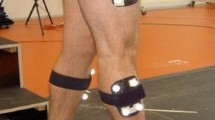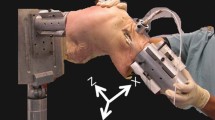Abstract
Purpose
The effect of double-bundle ACL reconstruction on knee kinematics has recently been studied by several authors under controlled laboratory conditions however little evidence has been derived from dynamic in vivo evaluations. This study hypothesized that tibial rotation during pivoting motor tasks would be better restored after double-bundle ACL reconstructions when compared with single-bundle procedures.
Methods
Twenty patients with a chronic ACL rupture were randomly assigned to receive a single- or double-bundle ACL reconstruction. Both knees were evaluated pre-operatively by kinematic 3-D gait analysis while performing low- and high-demand motor tasks, including pivoting. At 6 months post-operatively, measurements were repeated in 16 patients. Ten healthy, sex- and age-matched subjects with no history of lower limb pathology formed the control group. The tibial rotational excursion was set as the dependent variable.
Results
The results indicate that at 6 months after surgery both “anatomic” single- and double-bundle ACL reconstruction are able to restore tibial rotational excursion when compared with the contralateral knees and with control knees from uninjured subjects. Chronic ACL-deficient patients show an increase in tibial rotation in both knees during high-demand pivoting tasks.
Conclusions
Both “anatomic” single- and double-bundle ACL reconstruction adequately restore tibial rotational excursion in a human, “in vivo” kinematic model. As knee stability measurements by in vivo kinematic 3-D analysis more accurately represent actual knee loading during activities, the results of this study might better correlate with functional outcome after ACL reconstructions compared with static knee stability tests or ex vivo laboratory experiments. In such, the results of this dynamic study do not support the theoretical advantage of a double-bundle ACL reconstruction over an “anatomic” single-bundle ACL reconstruction.
Level of evidence
II.




Similar content being viewed by others
References
Barber SD, Noyes FR, Mangine RE, McCloskey JW, Hartman W (1990) Quantitative assessment of functional limitations in normal and anterior cruciate ligament-deficient knees. Clin Orthop Relat Res 255:204–214
Bellemans J, Eid T, Fabry G (1999) A modified technique for tibial interference screw fixation of hamstring anterior cruciate ligament grafts. Arthroscopy 15:669–671
Branch TP, Siebold R, Freedberg HI, Jacobs CA (2011) Double-bundle ACL reconstruction demonstrated superior clinical stability to single-bundle ACL reconstruction: a matched-pairs analysis of instrumented tests of tibial anterior translation and internal rotation laxity. Knee Surg Sports Traumatol Arthrosc 19:432–440
Desloovere K, Wong P, Swings L, Callewaert B, Vandenneucker H, Leardini A (2010) Range of motion and repeatability of knee kinematics for 11 clinically relevant motor tasks. Gait Posture 32:597–602
Ferber R, McClay Davis I, Williams DS 3rd, Laughton C (2002) A comparison of within- and between-day reliability of discrete 3D lower extremity variables in runners. J Orthop Res 20:1139–1145
Ferretti A, Monaco E, Labianca L, De Carli A, Maestri B, Conteduca F (2009) Double-bundle anterior cruciate ligament reconstruction: a comprehensive kinematic study using navigation. Am J Sports Med 37:1548–1553
Georgoulis AD, Papadonikolakis A, Papageorgiou CD, Mitsou A, Stergiou N (2003) Three-dimensional tibiofemoral kinematics of the anterior cruciate ligament-deficient and reconstructed knee during walking. Am J Sports Med 31:75–79
Grood ES, Suntay WJ (1983) A joint coordinate system for the clinical description of three-dimensional motions: application to the knee. J Biomech Eng 105:136–144
Ho JY, Gardiner A, Shah V, Steiner ME (2009) Equal kinematics between central anatomic single-bundle and double-bundle anterior cruciate ligament reconstructions. Arthroscopy 25:464–472
Lindstrom M, Fellander-Tsai L, Wredmark T, Henriksson M (2010) Adaptations of gait and muscle activation in chronic ACL deficiency. Knee Surg Sports Traumatol Arthrosc 18:106–114
Misonoo G, Kanamori A, Ida H, Miyakawa S, Ochiai N (2011) Evaluation of tibial rotational stability of single-bundle vs. anatomical double-bundle anterior cruciate ligament reconstruction during a high-demand activity—A quasi-randomized trial. Knee. Epub ahead of print. doi:10.1016/j.knee.2011.01.003
Motohashi M (2004) Profile of bilateral anterior cruciate ligament injuries: a retrospective follow-up study. J Orthop Surg (Hong Kong) 12:210–215
Müller W (1983) The knee: form, function and ligament reconstruction. The knee: form, function and ligament reconstruction. Springer-Verlag, Berlin
Park SJ, Jung YB, Jung HJ, Shin HK, Kim E, Song KS, Kim GS, Cheon HY, Kim S (2010) Outcome of arthroscopic single-bundle versus double-bundle reconstruction of the anterior cruciate ligament: a preliminary 2-year prospective study. Arthroscopy 26:630–636
Pinczewski LA, Lyman J, Salmon LJ, Russell VJ, Roe J, Linklater J (2007) A 10-year comparison of anterior cruciate ligament reconstructions with hamstring tendon and patellar tendon autograft: a controlled, prospective trial. Am J Sports Med 35:564–574
Ristanis S, Giakas G, Papageorgiou CD, Moraiti T, Stergiou N, Georgoulis AD (2003) The effects of anterior cruciate ligament reconstruction on tibial rotation during pivoting after descending stairs. Knee Surg Sports Traumatol Arthrosc 11:360–365
Ristanis S, Stergiou N, Patras K, Vasiliadis HS, Giakas G, Georgoulis AD (2005) Excessive tibial rotation during high-demand activities is not restored by anterior cruciate ligament reconstruction. Arthroscopy 21:1323–1329
Ristanis S, Stergiou N, Siarava E, Ntoulia A, Mitsionis G, Georgoulis AD (2009) Effect of femoral tunnel placement for reconstruction of the anterior cruciate ligament on tibial rotation. J Bone Joint Surg Am 91:2151–2158
Seon JK, Song EK, Park SJ (2006) Osteoarthritis after anterior cruciate ligament reconstruction using a patellar tendon autograft. Int Orthop 30:94–98
Shelbourne KD, Davis TJ, Klootwyk TE (1998) The relationship between intercondylar notch width of the femur and the incidence of anterior cruciate ligament tears. A prospective study. Am J Sports Med 26:402–408
Shen W, Forsythe B, Ingham SM, Honkamp NJ, Fu FH (2008) Application of the anatomic double-bundle reconstruction concept to revision and augmentation anterior cruciate ligament surgeries. J Bone Joint Surg Am 90(Suppl 4):20–34
Song EK, Oh LS, Gill TJ, Li G, Gadikota HR, Seon JK (2009) Prospective comparative study of anterior cruciate ligament reconstruction using the double-bundle and single-bundle techniques. Am J Sports Med 37(9):1705–1711
Stergiou N, Ristanis S, Moraiti C, Georgoulis AD (2007) Tibial rotation in anterior cruciate ligament (ACL)-deficient and ACL-reconstructed knees: a theoretical proposition for the development of osteoarthritis. Sports Med 37:601–613
Sward P, Kostogiannis I, Roos H (2010) Risk factors for a contralateral anterior cruciate ligament injury. Knee Surg Sports Traumatol Arthrosc 18:277–291
Takeda Y, Sato R, Ogawa T, Fujii K, Naruse A (2009) In vivo magnetic resonance imaging measurement of tibiofemoral relation with different knee flexion angles after single- and double-bundle anterior cruciate ligament reconstructions. Arthroscopy 25:733–741
Tashman S, Collon D, Anderson K, Kolowich P, Anderst W (2004) Abnormal rotational knee motion during running after anterior cruciate ligament reconstruction. Am J Sports Med 32:975–983
Tashman S, Kopf S, Fu FH (2008) The Kinematic Basis of ACL Reconstruction. Oper Tech Sports Med 16:116–118
Tegner Y, Lysholm J (1985) Rating systems in the evaluation of knee ligament injuries. Clin Orthop Relat Res 198:43–49
Teixeira da Fonseca S, Silva PL, Ocarino JM, Guimaraes RB, Oliveira MT, Lage CA (2004) Analyses of dynamic co-contraction level in individuals with anterior cruciate ligament injury. J Electromyogr Kinesiol 14(2):239–247
Tsarouhas A, Iosifidis M, Kotzamitelos D, Spyropoulos G, Tsatalas T, Giakas G (2010) Three-dimensional kinematic and kinetic analysis of knee rotational stability after single- and double-bundle anterior cruciate ligament reconstruction. Arthroscopy 26:885–893
van Eck CF, Schreiber VM, Liu TT, Fu FH (2010) The anatomic approach to primary, revision and augmentation anterior cruciate ligament reconstruction. Knee Surg Sports Traumatol Arthrosc 18:1154–1163
Webster KE, McClelland JA, Wittwer JE, Tecklenburg K, Feller JA (2010) Three dimensional motion analysis of within and between day repeatability of tibial rotation during pivoting. Knee 17:329–333
Yagi M, Wong EK, Kanamori A, Debski RE, Fu FH, Woo SL (2002) Biomechanical analysis of an anatomic anterior cruciate ligament reconstruction. Am J Sports Med 30:660–666
Yoo YS, Jeong WS, Shetty NS, Ingham SJ, Smolinski P, Fu F (2010) Changes in ACL length at different knee flexion angles: an in vivo biomechanical study. Knee Surg Sports Traumatol Arthrosc 18:292–297
Acknowledgments
The authors with like to express their appreciation to Dr. Pieter D’Hooghe, Ben Molenaers, and Katrien Fagard for their efforts concerning this study. The authors declare no potential conflict of interest regarding this study.
Author information
Authors and Affiliations
Corresponding author
Rights and permissions
About this article
Cite this article
Claes, S., Neven, E., Callewaert, B. et al. Tibial rotation in single- and double-bundle ACL reconstruction: a kinematic 3-D in vivo analysis. Knee Surg Sports Traumatol Arthrosc 19 (Suppl 1), 115–121 (2011). https://doi.org/10.1007/s00167-011-1568-z
Received:
Accepted:
Published:
Issue Date:
DOI: https://doi.org/10.1007/s00167-011-1568-z




